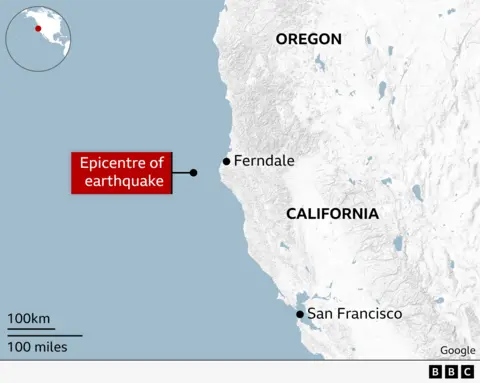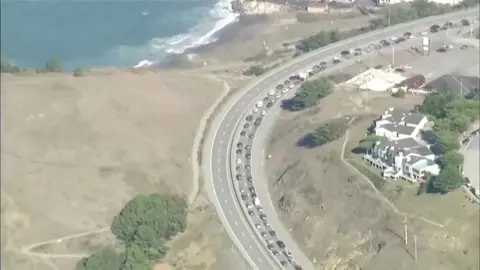Tsunami warning canceled after 7 earthquakes hit California

A 7.0 magnitude earthquake struck off the coast of northern California, according to the US Geological Survey.
A tsunami warning was initially issued along the coast of northern California and southern Oregon – an area of about 4.7 million people – but was later withdrawn.
The epicenter of the earthquake came near the city of Ferndale, California, a small town in Humboldt County about 260 miles (418km) north of San Francisco.
Local officials said no deaths or major damage were reported after the incident.
The Humboldt County Sheriff’s Office told CBS News, the BBC’s US partner, that there was no damage to buildings or infrastructure, but some homes reported minor damage.
Several stores in the area reported items falling off shelves and power outages for several residents, the sheriff’s office said.
More than 10,000 people were without power in Humboldt County after the earthquake struck, according to poweroutage.us.
Although the earthquake did not cause major damage, one resident of Ferndale who spoke to the BBC in the minutes after the quake said that the interior of the building he was in “looked like a bomb had exploded in every room”.
Olivia Cobian, innkeeper at the Gingerbread Mansion Inn in Ferndale, said the interior of the inn now “looks like a war zone”.
“We have large metal fireplaces that have been lifted and moved, everything has fallen, broken”.
Another witness to the quake was Todd Dunaway, who was having lunch at his home in Fortuna, California when the quake hit.
“It felt like standing on a huge bed of water,” he told the BBC. “The sound of windows slamming, walls creaking, dishes falling and decorations added to the drama and horror of it all as it happened. Naturally – you can’t help but wonder as it happens ‘Is this really that big?’
 Todd Dunaway
Todd DunawayMr Dunaway said he and his wife – who was also in the house – were shaking after 15 minutes waiting to see if there would be a bigger tremor.
His large swimming pool continued to flow violently for several minutes after the shaking stopped and lost about 18 inches (45cm) of water.
His sporting goods store had some damage, shoe boxes fell off the shelves, but nothing major, he said.
Several aftershocks were reported after the first earthquake, which struck at around 10:44 local time (18:44 GMT).
Some places, including the city of Berkeley in northern California, issued an evacuation order due to the threat of a possible tsunami.
“GET OUT NOW,” warned an X-post from the city. “The people in the Tsunami Zone are in BACK DANGER AND MUST EMERGE NOW. Stay east of 7th St. This is a formal order to leave now.”

Kayla Aihara was staying at a hotel in Half Moon Bay, California and received successive warnings about an earthquake and a possible tsunami.
Before the tsunami warning was cancelled, the hotel staff had told him to leave the gym and go to higher ground for fear of the tsunami’s impact.
Others went outside and said many people were gathered near the Pacific Coast Hotel, watching the waves and waiting for any signs of a tsunami.
California Governor Gavin Newsom was notified of the earthquake and met with state emergency officials to help coordinate the response.
At a ceremony on the US-Mexico border, the governor announced that he had signed a state of emergency declaration to help free resources in response to the earthquake.
He said the earthquake was “another reminder of the world we live in and the attitude we need to bring into our daily reality here in the state of California”.
 Reuters
ReutersTsunami signs line the streets of many communities along the US West Coast. They mark any “tsunami danger zone” and often point those in the area to evacuation routes that lead them to higher ground.
Those living in these tsunami zones are encouraged to practice their evacuation routes and have an emergency kit ready.
The California emergency website notes that a tsunami can strike 5 to 10 minutes after a major earthquake and sometimes the first wave that hits is not very large. It notes that if you see water draining from the shore and then rushing out to sea, “escape immediately to higher ground or inland”.
The US West Coast is the confluence of a number of Earth tectonic plates, and earthquakes are not uncommon. But earthquakes with a magnitude of 7 are not usually experienced in the region. Experts say between 10 and 15 such earthquakes strike the world each year.
The area has been hit by several major earthquakes, including the 1994 earthquake that struck Northridge, in the Los Angeles area, killing scores of people and injuring thousands more, as it caused billions of dollars in damage to homes and infrastructure.
Additional reporting by Alys Davies and Samanatha Granville
Source link





